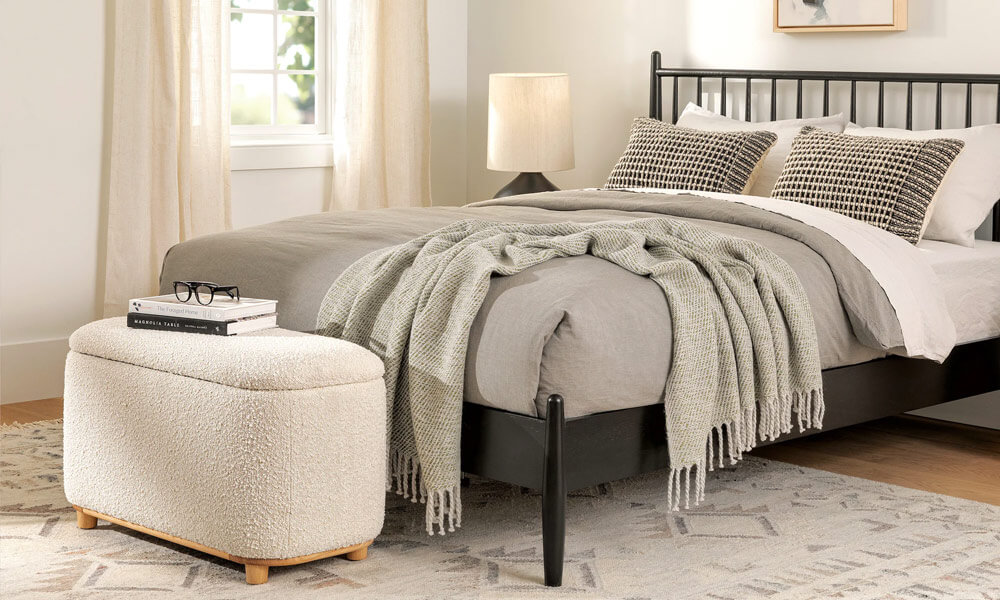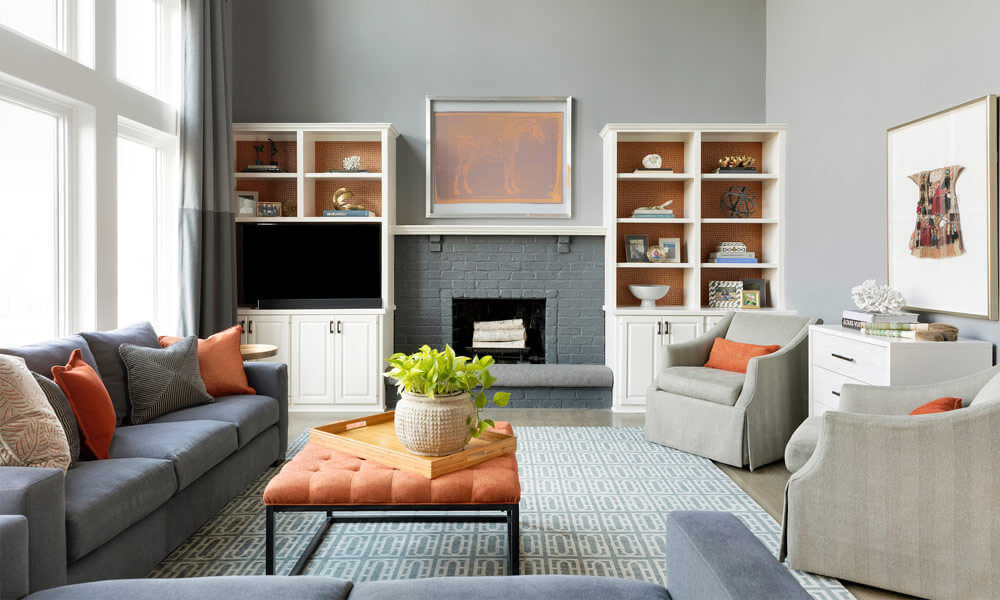What is an ottoman?
According to James Stanley, “ottomans are a favorite furniture piece to use in a home because of their versatility that can really do it all.” However, in the shadow of larger items like sofas and lounge chairs, these multi-functional pieces tend to be overlooked.
The ottoman was originally created by Turkish carpet weavers, who used bales of cotton to construct them. This type of furniture wasn’t introduced to Europe from Turkey (then, the Ottoman Empire) until the late 18th or early 19th century.
Today, ottomans are typically used as additional seating while entertaining, a coffee table, or a place to put your feet up in front of the sofa. Some, however, place ottomans in the bedroom– particularly, at the foot of the bed, to create seating or a place to drape clothing or accessories while getting ready in the morning.
Robin DeCapua says that she’s seen people use ottomans as a vanity stool, or extra storage for pillows, remotes, board games, and more. “Bonus points if you find an ottoman with a removable tray top, as it can serve as a handy side table as well,” says DeCapua.
Types of Ottomans
Just like many other pieces of furniture, ottomans are available in a variety of styles. “Ottomans come in different shapes, sizes, styles, types, and materials,” says Robin DeCapua. “Most are upholstered in some way, either completely or partially. However, some are made of natural materials like rattan. They're often sized similarly to a side table, but can be round, square, rectangular, or hexagonal.” Additionally, some chairs come with a matching ottoman. The classic Eames lounge chair and ottoman is an example of a matched set.
Ottoman Coffee Table / Cocktail Ottoman
An ottoman coffee table is an ottoman that has been merged with a coffee table to create a piece that does it all. These ottomans often have a hard surface connected to the ottoman or placed on top of the ottoman to create a hard surface for drinks to sit.
.jpeg)
Pouf
According to Robin DeCapua, “poufs are a particular type of ottoman that have become extremely popular in recent years.” These ottomans are affordable, stylish, and practical. “You’ve probably seen them in modern interior design blogs, magazine features, and all over Instagram,” DeCapua adds.

Many like poufs because they’re incredibly easy to move around the room as seating or a footstool, sort of like an adult bean bag chair.
Storage Ottoman
A favorite of small space dwellers, storage ottomans have extra storage space built into the piece, usually in the form of an upholstered top that lifts up to reveal a hidden cavity. James Stanley uses this sneaky storage option to keep his remote controls, seasonal throws, pillows, and magazines out of sight.

Tufted Ottoman
Tufted ottomans are ottomans created using an upholstery technique called tufting. These ottomans can be any size or shape, and are bring unique style and design to your space.
This style of ottoman pairs well with solid chairs, which accentuate the ottoman’s design, and linear accessories like trays or coffee table books.

Ottoman with Wheels
An ottoman with wheels (or a rolling ottoman) makes rearranging furniture even easier. Heather Bull says that her ottoman with wheels is “easy to move, even if the storage inside is full.”

These types of ottomans are perfect if you think you’re going to be using it for extra seating often, as the wheels mean that any guest can move it around to arrange it to their liking.
Oversized Ottoman
Oversized ottomans, a piece that has really made their mark in the last few years, serve as a practical piece for sitting, or can be used as a divider that creates a separation between rooms. These pieces are available in either square or rectangular varieties and create an exaggerated feel in any space.

It’s common to pair oversized ottomans with L-shaped sectionals, as they tend to fit well in between the two segments of the sofa.
Drum Ottoman
A tall, circular ottoman that serves as a footstool or perch for a glass, drum ottomans are a great accent piece in any space. Many purchase drum ottomans as a pair to display on either side of a sofa.

Additionally, many like that the drum ottoman is a smaller version of the typically large piece that also provides a bit of height, which creates variation in what is usually a space where most furniture is on the same level.
Waterfall Ottoman
Waterfall ottomans are curved, often upholstered pieces that bring an elegant shape to any space. According to Danielle Walish, waterfall ottomans have “a modern silhouette that looks especially nice at the foot of a bed.”
These ottomans are perfect for spaces with modern furniture or home decor, as the shape works well with the wavy edges and unique shapes commonly found in the modern aesthetic.

Ottoman Materials
When choosing an ottoman, keep both your existing home decor and personal style in mind. James Stanley recommends choosing a rich velvet or leather ottoman if you’re a city dweller, or a linen or rattan ottoman if you’re located on the coast. “And for a cozy look and feel, I recommend a more earthy and rustic ottoman with wood legs and upholstered fabrics,” says Stanley.
When Patricia Tram is choosing an ottoman, she prioritizes a firm seat. “This will make it more comfortable and inviting when you run out of chairs during game day or hosting a party,” she says. “This will make it more comfortable and inviting when you run out of chairs during game day or hosting a party. A firm seat will also make the ottoman an extra side table by adding a tray on top with some florals and coasters for guests.

For those particularly looking for an extra layer of durability, Tram suggests choosing a leather upholstered ottoman. “Leather upholstered ottomans add that extra layer of durability when you're needing a foot rest for your lounge chair, and who doesn't want to add another layer of comfort in the home?” says Tram.
On the other hand, if you’re pairing your ottoman with a chair, it’s better to have the same fabric so that they feel like a set. “But if you're adding ottomans as additional seating space in your living room, or they're at the end of your bed at the foot rail as an accent, I love doing a contrasting material,” says Tram. “Mixing textures and patterns make spaces feel welcoming, warm, and rich.”
Amandeep Brar agees, “Ottomans add so much texture and color to the space. Create contrast with your sofa and add a bit of drama with a beautifully textured ottoman."















